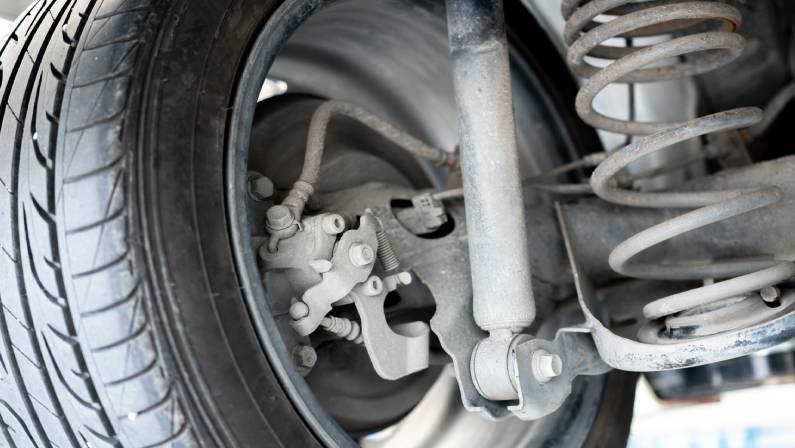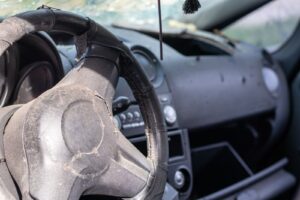It is responsible for ensuring a smooth ride, maintaining stability, and keeping the tires in contact with the road surface. In this article, we will explain what suspension is, how it works, and why it is so important.
What is a car suspension?

What is the role of a suspension?
The suspension system in a car has several important functions, including:
- Absorbing shocks and vibrations: In order to stop road shocks and vibrations from being communicated to the car’s occupants, the suspension system works to absorb them.
- Keeping stability: The suspension system aids in keeping the automobile stable, particularly while cornering, stopping, or accelerating.
- Maintaining tire contact with the ground: The suspension system aids in maintaining tire contact with roads, improving traction, handling, and steering control.
- Improving handling: A well-designed suspension system can improve the handling of the car, providing better control and responsiveness.
- Reducing body roll: The suspension system helps to reduce body roll during cornering, improving the car’s stability and reducing the risk of rollover.
Why makes the suspension so important?

The suspension system is critical for a pleasant, safe, and entertaining driving experience. A well-maintained suspension system may also save money in the long term by lowering the risk of accidents, increasing tire life, and boosting fuel efficiency.
It is critical to keep your car’s suspension system in excellent working order and to have it tested on a regular basis by a skilled mechanic.
Status Automotive & Collision provides suspension maintenance and repair in Houston, TX that will make you confident about having a safe and smooth ride.
What are the main types of suspension?
There are various types of suspension systems used in cars today, each with its own set of benefits and drawbacks. The type of suspension system used depends on various factors, such as the car’s intended use, cost, and design.
Here are the following:
Dependent suspension
A dependent suspension system is one in which the movement of one wheel on the same axle impacts the movement of the other wheel. This sort of suspension system is common in older vehicles and is less expensive to produce than independent suspension systems.
Dependent suspension systems, on the other hand, do not give the same level of comfort, stability, or handling as independent suspension systems, especially on poor roads or during emergency maneuvers.
Independent suspension
The movement of one wheel on the same axle does not impact the movement of the other wheel on the same axle in an independent suspension system.
Independent suspension systems outperform dependent suspension systems in terms of comfort, stability, and handling, especially on poor roads or during emergency maneuvers.
There are various types of independent suspension systems utilized in modern automobiles, including the MacPherson strut, double wishbone, and multi-link.
Semi-Independent Suspension
A semi-independent suspension system is a hybrid of dependent and independent systems. Some SUVs, pickup trucks, and vans employ this sort of suspension system.
Semi-independent suspension systems outperform dependent suspension systems in terms of comfort, stability, and handling, but they fall short of independent suspension systems.
Semi-independent suspension systems connect the wheels on the same axle using a torsion beam, trailing arm, or twist beam.
What components comprise the suspension system?

A car’s suspension system is made up of various parts that work together to produce a smooth and pleasant ride while also preserving stability and handling. Spring, shock absorbers, struts, control arms, ball joints, sway bars, and bushings are examples of these components.
Springs
Springs are the fundamental components of the suspension system that absorb road stress and vibration. Suspension systems employ a variety of springs, including coil springs, leaf springs, and torsion bars. The type of spring utilized depends on the design and intended function of the vehicle.
Shock absorbers
Shock absorbers work together with the springs to control the movement of the suspension system. They help to dampen the oscillation of the springs, preventing the car from bouncing excessively. Shock absorbers also help to maintain tire contact with the road surface, improving traction and handling.
Struts
Struts are shock absorbers that also act as structural components of the suspension system. Struts offer support and stiffness to the suspension system, which improves handling and stability.
Control arms
Control arms connect the suspension system to the car’s chassis, providing support and stability to the suspension system. Control arms also help to maintain the alignment of the wheels, improving handling and reducing tire wear.
Ball joints
Ball joints are crucial suspension system components that link the control arms to the steering knuckles. Ball joints allow the suspension system to move and rotate smoothly, increasing handling and steering responsiveness.
Sway bars
Sway bars contribute to better handling and stability by reducing body roll during turns. Sway bars connect the suspension systems on either side of the automobile, giving the suspension system more support and rigidity.
Bushings
Bushings are tiny components that cushion and support the moving portions of the suspension system, such as control arms and sway bars. Bushings absorb shocks and vibrations, which reduces noise and improves ride comfort.
What are the most common suspension issues?

The suspension system of a car is an important component that enables a smooth and pleasant ride while retaining stability and control. However, the suspension system can develop a variety of issues over time, resulting in a rough ride and diminished road safety.
Here are the most frequent suspension issues:
Worn-out springs
Springs are the most important components of the suspension system because they absorb road shocks and vibrations. Springs can wear down over time, causing the automobile to droop or bounce excessively.
Tire wear, reduced stability, and poor handling can all be caused by worn-out springs. It is critical to replace worn-out springs in order to restore the suspension system’s performance and maintain a smooth and safe ride.
Leaking shock absorbers
Shock absorbers and springs work together to regulate the movement of the suspension system. Shock absorbers can leak over time, causing the vehicle to bounce excessively and impair stability and control. Leaking shock absorbers can also cause tire wear and increase braking distance, jeopardizing road safety.
Damaged struts
Struts are a type of shock absorber that also serves as a structural component of the suspension system. Damaged struts can cause the car to bounce excessively, reduce stability, and compromise handling.
Damaged struts can also cause tire wear, increase braking distance, and lead to premature wear of other suspension components. Replacing damaged struts is essential to restore the suspension system’s function and ensure a smooth and safe ride.
Loose or broken anti-sway bars
Worn-out bushings
Bushings are small components that provide cushioning and support to the suspension system’s moving parts, such as control arms and sway bars. Over time, bushings can wear out, causing the car to vibrate excessively, produce noise, and reduce stability and handling.
Keep a Safe and Comfortable Driving Experience With a Good Suspension System
Overall, the suspension system is an important component of every vehicle, as it ensures a smooth and pleasant ride, superior handling, and road safety. Let Status Automotive & Collision do the work for you.
For the past 15 years, we have been a dependable partner for all automobile services in Houston, Texas.




